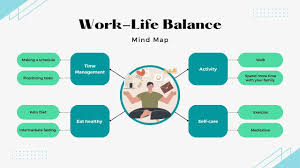Finding the right balance between work and personal life is one of the greatest challenges of our time. With constant emails, social media distractions, and workplace demands, many people struggle to maintain harmony between their careers and personal well-being. A poor work-life balance can lead to stress, burnout, and even health issues, while a healthy balance helps you stay productive, happy, and fulfilled.
This article explores Work-Life Balance Hacks that can help you manage your time better, boost productivity, and create more space for the things you love.

Why Work-Life Balance Matters
Work-life balance is not just about spending equal hours on work and personal life. It’s about creating a lifestyle where professional responsibilities and personal needs coexist without overwhelming each other.
- Better health: Chronic stress from poor balance can cause fatigue, insomnia, anxiety, and weakened immunity.
- Stronger relationships: Spending quality time with family and friends fosters emotional support and happiness.
- Higher productivity: People who rest well and disconnect from work often return with more energy and creativity.
- Long-term career success: A balanced lifestyle reduces burnout, helping you sustain your career over time.
Common Challenges to Work-Life Balance Hacks
Before diving into hacks, it’s important to understand what gets in the way:
- Blurred boundaries – Remote work often makes it harder to separate office time from personal time.
- Overcommitment – Saying yes to too many projects or responsibilities can eat into personal time.
- Poor time management – Without a clear schedule, tasks pile up, leading to longer work hours.
- Technology overload – Constant notifications make it difficult to “switch off” after work.
By identifying these challenges, you can choose the hacks that best fit your situation.

Work-Life Balance Hacks for Everyday Life
1. Set Clear Boundaries
One of the simplest yet most effective hacks is drawing the line between work and personal life.
- Define working hours and stick to them.
- Avoid answering work emails late at night or during family time.
- If working from home, create a designated workspace so you mentally “leave work” at the end of the day.
Boundaries signal to both you and others when it’s time to work and when it’s time to rest.
2. Master the Art of Prioritization
Not all tasks are created equal. Use the Eisenhower Matrix (urgent vs. important) to focus on what really matters.
- Do first: Urgent and important tasks.
- Schedule: Important but not urgent tasks.
- Delegate: Tasks that someone else can handle.
- Eliminate: Tasks that waste time and bring no value.
This approach prevents you from working long hours on tasks that don’t significantly impact your goals.
3. Time-Blocking Your Schedule
Time-blocking is a productivity technique where you dedicate specific time slots to tasks.
- Mornings for deep, focused work.
- Afternoons for meetings or collaborative tasks.
- Evenings for personal time, hobbies, or rest.
By structuring your day in blocks, you minimize distractions and make time for both professional and personal activities.

4. Learn to Say “No”
Overcommitting is one of the fastest ways to burn out. Saying no doesn’t mean you’re lazy or unhelpful—it means you value your time.
- Decline extra projects if they don’t align with your goals.
- Set limits on social commitments if you need downtime.
- Be polite but firm: “I’d love to help, but I’m fully committed right now.”
This frees up space for the things that truly matter.
5. Take Advantage of Technology Wisely
Technology can be both a blessing and a curse. Use it strategically:
- Task managers (Trello, Asana, Notion) to organize projects.
- Calendar apps to set reminders for work and personal events.
- Focus tools like website blockers to prevent social media distractions.
At the same time, remember to disconnect from tech after work hours.
6. Practice Mindful Transitions
The switch between work and personal life can be stressful. Create rituals that help you transition smoothly.
- Take a short walk after finishing work.
- Listen to music or a podcast to signal “end of the day.”
- Write a quick journal entry to close out work thoughts.
Mindful transitions help your brain shift gears, reducing stress.
7. Protect Your Personal Time
Your free time should be treated as non-negotiable.
- Schedule “me-time” in your calendar.
- Dedicate weekends to hobbies, family, or rest.
- Avoid letting work spill into vacations—consider turning off work notifications.
When you honor your personal time, you recharge and return to work more energized.

Work-Life Balance Hacks
8. Incorporate Exercise and Healthy Habits
Physical health plays a huge role in maintaining work-life balance.
- Exercise regularly, even short 20-minute walks.
- Maintain a healthy diet to keep energy levels up.
- Get 7–8 hours of quality sleep every night.
When your body feels good, you handle stress better and remain more productive.
9. Delegate and Outsource
You don’t have to do everything yourself.
- At work, delegate tasks to team members.
- At home, outsource chores like grocery delivery or cleaning if possible.
- Share responsibilities with family members.
Delegating reduces workload and frees time for important priorities.
Table of Contents
10. Use the 80/20 Rule (Pareto Principle)
The Pareto Principle suggests that 20% of your activities produce 80% of results.
- Identify which tasks give you the most impact at work.
- Focus on high-value activities instead of busy work.
- Apply the same principle in personal life—prioritize activities that bring you the most joy.
This hack prevents you from wasting time on tasks that don’t really matter.
11. Unplug to Recharge
Constant connectivity can drain you. Make it a habit to unplug:
- Set phone-free hours, especially before bed.
- Try digital detox weekends once in a while.
- Replace screen time with activities like reading, cooking, or meditation.
Unplugging allows you to reset mentally and emotionally.
12. Practice Self-Care Consistently
Self-care isn’t selfish—it’s necessary for balance.
- Meditate for stress relief.
- Enjoy hobbies that bring joy.
- Treat yourself with kindness, whether it’s a spa day, a favorite meal, or simple relaxation.
Taking care of yourself ensures you have the energy to take care of others and meet your responsibilities.
“Work-Life Balance Hacks: Simple Strategies to Stay Productive, Happy, and Stress-Free”

Work-Life Balance Hacks for Specific Situations
For Remote Workers
- Set clear start and end times.
- Dress as if going to work to create a mental shift.
- Take regular breaks away from your desk.
For Parents
- Share responsibilities with your partner or family.
- Involve kids in simple household tasks.
- Plan family activities to strengthen bonds.
For Entrepreneurs
- Separate personal finances from business finances.
- Hire help when possible instead of doing everything yourself.
- Schedule downtime just as you would schedule meetings.
“Work-Life Balance Hacks: Simple Strategies to Stay Productive, Happy, and Stress-Free”
Long-Term Benefits of Work-Life Balance
Applying these hacks isn’t just about surviving daily routines—it brings long-term rewards:
- Improved mental health: Less stress and anxiety.
- Stronger personal relationships: More time with loved ones.
- Higher career satisfaction: Avoiding burnout leads to steady growth.
- Better lifestyle: Time for hobbies, passions, and meaningful experiences.
Final Thoughts
Work-life balance isn’t a one-time achievement; it’s an ongoing practice. Life changes, careers evolve, and responsibilities shift, which means you’ll need to adjust your strategies over time. The key is to stay mindful of your priorities and make deliberate choices about how you spend your time.
By applying these Work-Life Balance Hacks, you can create a lifestyle where work fuels your ambitions without overshadowing your health, happiness, and relationships.
